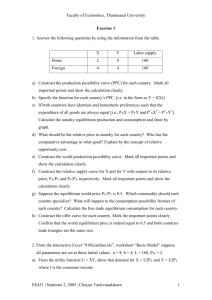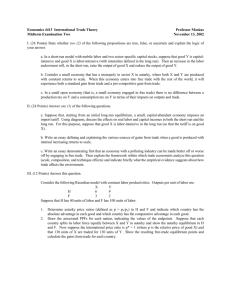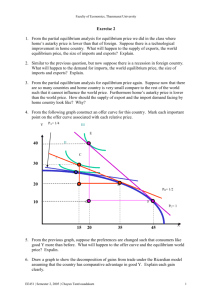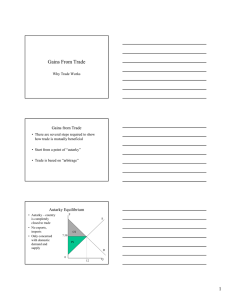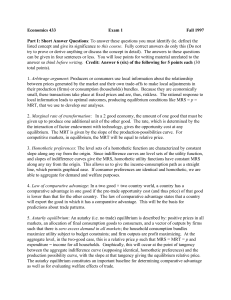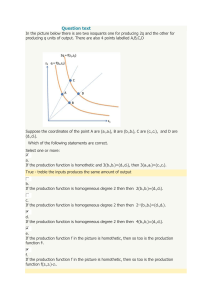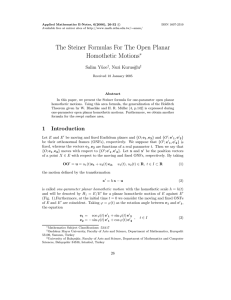Lapan Econ 655 Fall 2004
advertisement
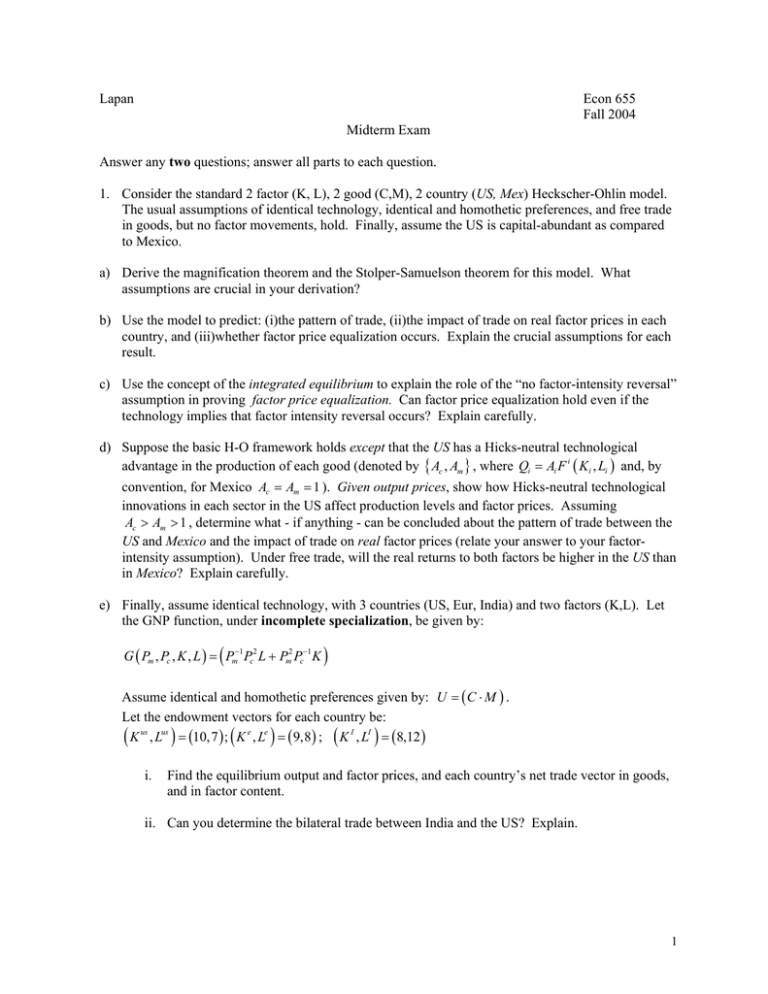
Lapan
Econ 655
Fall 2004
Midterm Exam
Answer any two questions; answer all parts to each question.
1. Consider the standard 2 factor (K, L), 2 good (C,M), 2 country (US, Mex) Heckscher-Ohlin model.
The usual assumptions of identical technology, identical and homothetic preferences, and free trade
in goods, but no factor movements, hold. Finally, assume the US is capital-abundant as compared
to Mexico.
a) Derive the magnification theorem and the Stolper-Samuelson theorem for this model. What
assumptions are crucial in your derivation?
b) Use the model to predict: (i)the pattern of trade, (ii)the impact of trade on real factor prices in each
country, and (iii)whether factor price equalization occurs. Explain the crucial assumptions for each
result.
c) Use the concept of the integrated equilibrium to explain the role of the “no factor-intensity reversal”
assumption in proving factor price equalization. Can factor price equalization hold even if the
technology implies that factor intensity reversal occurs? Explain carefully.
d) Suppose the basic H-O framework holds except that the US has a Hicks-neutral technological
advantage in the production of each good (denoted by { Ac , Am } , where Qi = Ai F i ( K i , Li ) and, by
convention, for Mexico Ac = Am = 1 ). Given output prices, show how Hicks-neutral technological
innovations in each sector in the US affect production levels and factor prices. Assuming
Ac > Am > 1 , determine what - if anything - can be concluded about the pattern of trade between the
US and Mexico and the impact of trade on real factor prices (relate your answer to your factorintensity assumption). Under free trade, will the real returns to both factors be higher in the US than
in Mexico? Explain carefully.
e) Finally, assume identical technology, with 3 countries (US, Eur, India) and two factors (K,L). Let
the GNP function, under incomplete specialization, be given by:
G ( Pm , Pc , K , L ) = ( Pm−1 Pc2 L + Pm2 Pc−1 K )
Assume identical and homothetic preferences given by: U = ( C ⋅ M ) .
Let the endowment vectors for each country be:
( K us , Lus ) = (10,7 ) ; ( K e , Le ) = ( 9,8) ; ( K I , LI ) = (8,12 )
i.
Find the equilibrium output and factor prices, and each country’s net trade vector in goods,
and in factor content.
ii. Can you determine the bilateral trade between India and the US? Explain.
1
2.
Answer all parts.
(a) Consider a simple model with 2 countries (US, Europe) and three goods (C, M, S). Goods C and M
are final goods (consumed by households), while S is a pure intermediate good. The production
technologies are given by:
US:
Europe:
i.
Qc = Min ⎡⎣( Lc 2 ) , ( Sc 2 ) ⎤⎦ ; Qm = ( Lm 3) ; Qs = ( Ls 2 )
Qc = Min ⎡⎣ Lc , ( Sc 2 ) ⎤⎦ ; Qm = ( Lm 3) ; Qs = ( Ls 4 )
Assuming trade is allowed in final goods, but not in intermediate goods, find the pattern of
trade, the range for the post trade relative prices of final goods, and the range for the relative
wage rate. Compare this equilibrium to autarky, and discuss how trade affects the real wage in
each country.
ii. Suppose a new agreement is signed between Europe and the US that allows trade in all 3 goods.
What can you now conclude about the pattern of trade? Does trade in intermediate goods
increase efficiency? (i.e., is it possible to produce more of all final goods than before)? Explain.
iii. Let Lus , Le denote the labor forces for each country. Given internationally identical and
homothetic preferences: U = ( Dc Dm ) , find the equilibrium prices and wages, assuming no
trade in S (your answer should specify the solutions over the whole domain of ( Le Lus ) ).
iv. Using the endowments and preferences from part (iii), find the equilibrium, assuming all goods
are tradable. Compare your answers to (iii) and (iv), paying particular attention to the pattern of
trade, relative wages, and welfare in each country (your answer should specify the solutions
over the whole domain of ( Le Lus ) ).
(b) Consider a simple Ricardian model with two goods, three countries (US, Europe, Japan). Labor
productivities are given by:
Labor productivity US
C
2
4
M
6
2
i.
Europe
Japan
3
3
Assume initially there is free trade between Europe and the US, but no trade with Japan.
Characterize equilibrium prices and real wages in each country.
ii. Assume discussions are under way to allow Japan to join the free trade area. If Japan joins:
(1)what will the pattern of trade be among the nations? And (2)Who will gain and will
anybody lose if Japan joins? Be as specific as possible. Finally, (3)if there is a loser, and if
income transfers are allowed, will it be possible for the winners to compensate the loser(s)
so that – given compensation – everybody is better off after Japan joins the free trade area?
2
3.
Answer all parts.
G
G G
(a) Let R p,V be the GNP function and e ( p,U ) be the expenditure function for a representative
(
)
agent. Use these functions to prove that the movement from autarky to trade (not necessarily freeG
trade) is welfare-improving. Explain what assumptions are used (take the input vector V as fixed).
(b) Using the same approach as in part (a), assume there are N goods. Assume the country in question
G
is small, facing exogenous world prices p w .
i.
Given that trade in good N is not permitted, will moving from autarky to trade in the other (N1) goods necessarily be welfare improving? Prove your answer.
ii. Assume there is currently trade in the (N-1) goods and that there is a tariff on good 1 (only).
Will permitting trade in the Nth good necessarily raise welfare? Prove your answer and explain
your results. (Continue to use the small country assumption).
(c) Consider the expenditure-revenue approach with two countries (US, Europe). Suppose preferences
G G
are identical and homothetic across countries, but the GNP functions differ. Let R u p,V u and
G G
R e p,V e denote the GNP functions for the US and Europe, respectively (the notation implies that
(
)
(
)
the function, as well as the input endowment vector, may differ across countries). Given this setup:
i.
Show how the trade equilibrium is determined and prove what, if anything, can be concluded
about the pattern of trade in goods (relate your answer to autarky prices).
ii. What can be concluded about the pattern of trade in the N good Ricardian model? Are the
predictions for the Ricardian model more specific than in (i), and if so, why?
iii. Will free trade in goods equalize factor prices in this model? If not, assume the return on factor
1 is higher in the US than in Europe. Suppose trade is now allowed in factor 1, as well as in
goods. Will allowing trade in this factor increase economic efficiency? Will both countries
necessarily gain from this trade? Explain. In answering, assume there are only two goods, but
more than two factors (a proof would be welcome, but if you cannot provide a proof, provide an
economic discussion).
iv. Would your answer to part (iii), concerning the welfare impact of allowing trade in factor 1,
change if there were a tariff on good 1? Explain your logic.
(d) First, explain why, if there is a domestic externality, you can’t necessarily use the GNP function and
the expenditure function to represent equilibrium production, consumption and utility levels. Next
consider a N good model, and assume that domestic production of good 1 creates an externality that
hurts consumers (who are all alike). The direct utility function for each consumer is:
U = φ ( z ) H ( c1h ,..., cnh ) ; z = J ( q1 ) ; φ ′ < 0, J ′ > 0 where cih is consumer h’s consumption of good
i, and z denotes pollution, caused by output of good one.
i.
Characterize the autarky equilibrium.
ii. If the country is small, under what conditions can you be sure free trade is preferred to autarky?
Prove your answer (if you can’t, at least give a logical discussion!).
3

